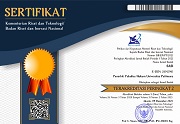Kerugian Keuangan Negara atau Perekonomian Negara Dalam Menentukan Hukuman Mati Pada Tindak Pidana Korupsi
 )
)
(1) Program Magister Ilmu Hukum Universitas Padjadjaran, Indonesia
 Corresponding Author
Corresponding Author
Abstract
The difficulty of capital punishment for perpetrators of corruption, although there are several examples of corruption cases that have fulfilled certain elements of the conditions as Article 2 paragraph (2) of Law Number 20 of 2002 concerning Amendments to Law Number 31 of 1999 concerning Eradication of Corruption Crimes. To discuss this problem, the research method used is juridical normative relating to certain elements of the state and the amount of state financial losses or the state's economy in determining the death penalty. The results of the discussion included not explaining the specific elements of certain circumstances as a burden for corruptors. In addition, the amount of state financial losses or the country's economy is very important in determining the death penalty is not formulated in certain circumstances. Therefore, it is recommended that specific formulations of certain elements and the amount of state financial losses or state economies that reach billions of up to triulian rupiah be subject to the death penalty.
Keywords
DOI
10.47268/sasi.v26i1.210
Published
2020-05-19
How To Cite
@article{SASI210,
author = {Herman Katimin},
title = {Kerugian Keuangan Negara atau Perekonomian Negara Dalam Menentukan Hukuman Mati Pada Tindak Pidana Korupsi},
journal = {SASI},
volume = {26},
number = {1},
year = {2020},
keywords = {State Financial Losses and State Economy; Corruption; Death Penalty; Certain Circumstances},
abstract = {The difficulty of capital punishment for perpetrators of corruption, although there are several examples of corruption cases that have fulfilled certain elements of the conditions as Article 2 paragraph (2) of Law Number 20 of 2002 concerning Amendments to Law Number 31 of 1999 concerning Eradication of Corruption Crimes. To discuss this problem, the research method used is juridical normative relating to certain elements of the state and the amount of state financial losses or the state's economy in determining the death penalty. The results of the discussion included not explaining the specific elements of certain circumstances as a burden for corruptors. In addition, the amount of state financial losses or the country's economy is very important in determining the death penalty is not formulated in certain circumstances. Therefore, it is recommended that specific formulations of certain elements and the amount of state financial losses or state economies that reach billions of up to triulian rupiah be subject to the death penalty.},
issn = {2614-2961}, pages = {39--51} doi = {10.47268/sasi.v26i1.210},
url = {https://fhukum.unpatti.ac.id/jurnal/sasi/article/view/210}
}
Buku
[1] Ali, Mahrus. (2011). Dasar-dasar Hukum Pidana, Jakarta: Sinar Grafika.
[2] Chaerudin, Syhaiful Ahmad Dinas dan Dafillah, Syarif. (2008). Strategi Pencegahan dan Penegakan Hukum Tindak Pidana Korupsi, Bandung: Refika Aditama.
[3] Hadikusuma, H. (1995). Metode Pembuatan Kertas Kerja atau Skripsi Ilmu Hukum. Bandung: Mandar Maju.
[4] Pascoe, Daniel dkk. (2016). Politik Hukuman Mati di Indonesia, Serpong: Marjin Kiri.
[5] Saleh, Roeslan. (1987). Sifat Melawan Hukum dari Perbuatan Melawan Hukum Pidana¸ Jakarta: Aksara Baru.
[6] Sumaryanto, Djoko. (2019). Pengembalikan Beban Pembuktian Tindak Pidana dalam Rangka Pengembalian Kerugian Negara, Jakarta: Prestasi Pustaka.
[7] Wiyono, R. (2009). Pembahasan Undang-Undang Pemberantasan Tindak Pidana Korupsi, Jakarta: Sinar Grafika.
Jurnal dan Lain-Lain
[8] Adji, Indriyanto Seno. (2001). Pidana mati Bagi Koruptor Sebagai Upaya Pemberantasan Korupsi, Jurnal Keadilan.
[9] Hikmah dan Sopoyono, Eko. (2019). Kebijakan Formulasi Sanksi Pidana Terhadap Pelaku Tindak Pidana Korupsi Berbasis Nilai Keadilan, Jurnal Pembangunan Hukum Indonesia, Volume 1, Nomor 1.
[10] Muwahid. (2005). Penerapan Hukuman Mati Bagi Pelaku Tindak Pidana Korupsi Sebagai Upaya Progresif dalam Pemberantasan Korupsi, Jurnal Hukum Uin Sunan Ampel Surabaya, Al-Quanun, Vol. 18 No. 2.
[11] Pribadi, Muhammaf Arif dkk. (2015). Eksistensi Pidana Mati Dalam Tindak Pidana Korupsi Terkait Pembaharuan Hukum Pidana Di Indonesia, Fakultas Hukum Universitas Brawijaya, Jurnal Hukum Universitas Brawijaya.
[12] Purba, Elizabeth. (2018). Hukuman Mati Terhadap Pelaku Tindak Pidana Korupsi di Berbagai Negara yang menerapkan hukuman mati (Indonesia, Cina dan Thailand), Jurnal Mahupiki, Vol 1, No 4.
[13] Sidauruk, Bornok Mariantha. (2011). Prospek Penerapan Sanksi Pidana Mati Bagi Pelaku Tindak Pidana Korupsi Di Indonesia,Skripsi Fakultas Hukum, Universitas Negeri Semarang.
[14] Toule, Elsa R.M. (2013). Eksistensi Ancaman Pidana Mati dalam Undang-Undang TIndak Pidana Korupsi, Jurnal Hukum Prioris, Vol. 3 No. 3.
[15] Yanto, Oksidelfa. (2017). Penjatuhan pidana mati pelaku tindak pidana korupsi dalam keadaan tertentu (Death Penalty To Corruptors In a Certain Condition), Jurnal Legislasi Indonesia, Indonesia Journal of Legislation, Vol 14, No 1.
[16] Rofii, M. Sya’roni. Hukuman Mati Bagi Koruptor : Sebuah Diskursus Mendesak Di Masa Kritis. Istinbath : Jurnal Hukum, [S.L.], V. 12, N. 1, P. 53-65, May 2015. Issn 1829-8117. Available At: Http://E-Journal.Metrouniv.Ac.Id/Index.Php/Istinbath/Article/View/575.
[17] https://news.detik.com/berita/d-3987822/hakim-korupsi-e-ktp-rugikan-negara-rp-23-triliun.
[20] https:// www. kejaksaan.go.id/unit_ kejaksaan.php?idu =31&idsu=47&idke=0&hal=78&id =1893&bc=.
[21] https://www.tagar.id/kasus-korupsi-kementerian-agama-dana-haji-sampai-jual-beli-jabatan.
[22] https://republika.co.id/berita/kolom/fokus/plgszk318/korupsi-di-atas-penderitaan-korban-bencana-alam.
[23] https://metropekanbaru.com/icw-bupati-kudus-mengulang-korupsi-cabut-saja-hak-politik-koruptor/.
Cited-By:
1. Analisis Yuridis Penerapan Konsep Asas Lex Specialis Sytematis Dalam Tindak Pidana Perpajakan
Miftahul Jannah
Journal of Contemporary Law Studies vol: 2 issue: 2 first page: 141 year: 2024
Type: Journal [View Source]
| Dublin Core | PKP Metadata Items | Metadata for this Document | |
| 1. | Title | Title of document | Kerugian Keuangan Negara atau Perekonomian Negara Dalam Menentukan Hukuman Mati Pada Tindak Pidana Korupsi |
| 2. | Creator | Author's name, affiliation, country | Herman Katimin; Program Magister Ilmu Hukum Universitas Padjadjaran; Indonesia |
| 3. | Subject | Discipline(s) | |
| 3. | Subject | Keyword(s) | State Financial Losses and State Economy; Corruption; Death Penalty; Certain Circumstances |
| 4. | Description | Abstract | The difficulty of capital punishment for perpetrators of corruption, although there are several examples of corruption cases that have fulfilled certain elements of the conditions as Article 2 paragraph (2) of Law Number 20 of 2002 concerning Amendments to Law Number 31 of 1999 concerning Eradication of Corruption Crimes. To discuss this problem, the research method used is juridical normative relating to certain elements of the state and the amount of state financial losses or the state's economy in determining the death penalty. The results of the discussion included not explaining the specific elements of certain circumstances as a burden for corruptors. In addition, the amount of state financial losses or the country's economy is very important in determining the death penalty is not formulated in certain circumstances. Therefore, it is recommended that specific formulations of certain elements and the amount of state financial losses or state economies that reach billions of up to triulian rupiah be subject to the death penalty. |
| 5. | Publisher | Organizing agency, location | Faculty of Law, Universitas Pattimura |
| 6. | Contributor | Sponsor(s) | |
| 7. | Date | (YYYY-MM-DD) | 2020-05-19 |
| 8. | Type | Status & genre | Peer-reviewed Article |
| 8. | Type | Type | |
| 9. | Format | File format | PDF (Bahasa Indonesia) |
| 10. | Identifier | Uniform Resource Identifier | https://fhukum.unpatti.ac.id/jurnal/sasi/article/view/210 |
| 10. | Identifier | Digital Object Identifier | 10.47268/sasi.v26i1.210 |
| 11. | Source | Title; vol., no. (year) | SASI; Vol 26, No 1 (2020): Volume 26 Nomor 1, Januari - Maret 2020 |
| 12. | Language | English=en | id |
| 13. | Relation | Supp. Files | |
| 14. | Coverage | Geo-spatial location, chronological period, research sample (gender, age, etc.) | |
| 15. | Rights | Copyright and permissions | Copyright: Authors who publish their manuscripts in this Journal agree to the following conditions: 1. The copyright in each article belongs to the author, as well as the right to patent. 2. Authors can enter into separate, additional contractual arrangements for the non-exclusive distribution of the journal's published version of the work (e.g., post it to an institutional repository or publish it in a book), with an acknowledgment of its initial publication in this journal. 3. Authors are permitted and encouraged to post their work online (e.g., in institutional repositories or on their website) before and during the submission process, as it can lead to productive exchanges, as well as earlier and greater citation of published work. 4. Authors have the right to self-archiving of the article (Author Self-Archiving Policy)
License: The SASI Journal is disseminated based on the Creative Commons Attribution-NonCommercial 4.0 International license terms. This license allows anyone to copy and redistribute this material in any form or format, compose, modify, and make derivatives of this material for any purpose. You cannot use this material for commercial purposes. You must specify an appropriate name, include a link to the license, and certify that any changes have been made. You can do this in a way that is appropriate but does not imply that the licensor supports you or your use.
|
Copyright (c) 2020 Herman Katimin

This work is licensed under a Creative Commons Attribution-NonCommercial 4.0 International License.
Cited-By:
1. Analisis Yuridis Penerapan Konsep Asas Lex Specialis Sytematis Dalam Tindak Pidana Perpajakan
Miftahul Jannah
Journal of Contemporary Law Studies vol: 2 issue: 2 first page: 141 year: 2024
Type: Journal [View Source]

 : 11423 times
: 11423 times Download : 4267 times
Download : 4267 times
















